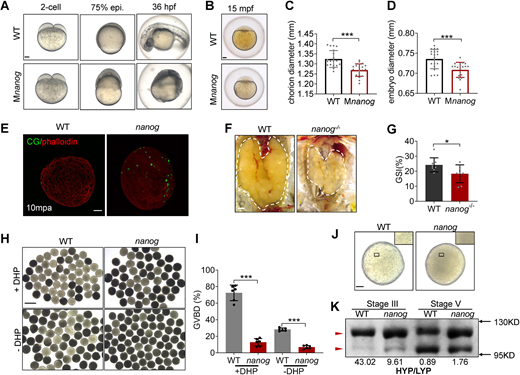Fig. 1 Loss of maternal nanog results in oocyte maturation defects. (A) Bright-field images showing the embryonic malformation of Mnanog mutants in contrast to time-matched WT embryos. Scale bar: 100 μm. (B) WT and Mnanog embryos with chorions at 15 mpf. Scale bar: 100 μm. (C,D) Measurement of chorion diameter and oocyte diameter at 15 mpf. ***P<0.001. n=20. (E) Representative images showing labeling of CGs in WT and nanog mutant eggs fixed at 10 mpa. F-actin was stained using phalloidin to show the outline of embryo. Scale bar: 100 μm. n=25. (F) Appearance of ovaries (outlined) dissected from WT and nanog−/− females. Scale bar: 1 mm. (G) The GSI of WT and nanog−/− females. n=8. *P<0.05. (H) Morphology of stage IV follicles dissected from WT and nanog−/− ovaries with or without incubation in DHP (1 μg/ml) for 2 h. Scale bar: 1 mm. (I) Comparison of the GVBD percentage in WT and nanog mutant follicles. Six fish of each group were analyzed. (J) Stage V follicles from WT and nanog mutant. Insets show enlarged regions of the yolk and relative opaqueness is seen in nanog mutants. Scale bar: 100 μm. (K) SDS-PAGE and Coomassie staining of major yolk proteins of stage III and stage V follicles. The higher and lower molecular weight yolk proteins (HYP and LYP) are indicated by the red arrowheads. HYP/LYP ratios were calculated (shown underneath) to represent yolk protein cleavage levels.
Image
Figure Caption
Acknowledgments
This image is the copyrighted work of the attributed author or publisher, and
ZFIN has permission only to display this image to its users.
Additional permissions should be obtained from the applicable author or publisher of the image.
Full text @ Development

